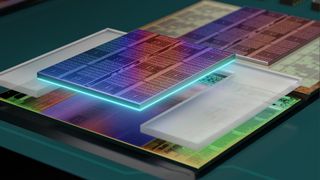You can create a RAM disk within the 3D V-Cache of an AMD X3D CPU if you really want to
A very fast, but very small 32MB RAM drive.

Now here's something interesting, if only for interest's sake. Twitter/X user Nemez managed to create a RAM disk held within the Level 3 cache of an AMD Ryzen 7 5800X3D processor and the results make the fastest NVMe drives look like sloths in comparison.
Nemez (via Tom's Hardware), used the CrystalDiskMark benchmark using some specific settings and achieved sequential read and write speeds of 182GB/s and 175GB/s respectively. In comparison, a fast PCIe 5.0 NVMe SSD can achieve around 12GB/s read and write speeds, meaning the L3 cache drive is more or less 15x faster. However, The peak bandwidth of a 5800X3D's L3 cache is up to 2TB/s, so these results are only using a fraction of its potential.
The FAT32 disk was created using OSFMount and tested with CrystalDiskMark 8.0.4 using the specific SEQ 256KB test, with a queue depth of 1 with 16 threads. Even then the test results were erratic. Of course, such a test is purely academic.
It needs to be said that using L3 cache for a RAM drive is very impractical, as even if you used all 96MB of the 5800X3D's cache, it's just too small to be of any use, and it's not designed to be accessible in such a way. AMD isn't likely to dedicate resources to perfect this kind of use case. Note that AMD's high end EPYC Genoa-X processors pack in over 1GB of L3 cache. That's big enough for a usable RAM disk if you really want to. Being a millionaire would help too.
A RAM disk works by treating a portion of volatile system RAM (or SRAM in the case of AMD's V-Cache) as if it were a disk drive. RAM disks were more popular in the past, even though they were never seen as mainstream.
A properly configured RAM drive delivered performance orders of magnitude faster than mechanical hard drives, and some apps thrived on the high bandwidth and low latency on offer from a large enough RAM drive.
Who knows? In the future AMD might have consumer V-Cache CPUs with a lot more than 96MB of stacked L3 cache. I think housing a 150GB game inside L3 cache isn't going to happen anytime soon though. And anyway, if it ever became possible, by then game sizes will probably take up a terabyte or three…
The biggest gaming news, reviews and hardware deals
Keep up to date with the most important stories and the best deals, as picked by the PC Gamer team.
Best Black Friday PC gaming deals:
All the best discounts in one place
How to avoid overpaying on a Black Friday gaming laptop deal: How much to pay, and where to buy from
How to spot the best Black Friday prebuilt deal:
Don't pay over the odds for a PC this year

Chris' gaming experiences go back to the mid-nineties when he conned his parents into buying an 'educational PC' that was conveniently overpowered to play Doom and Tie Fighter. He developed a love of extreme overclocking that destroyed his savings despite the cheaper hardware on offer via his job at a PC store. To afford more LN2 he began moonlighting as a reviewer for VR-Zone before jumping the fence to work for MSI Australia. Since then, he's gone back to journalism, enthusiastically reviewing the latest and greatest components for PC & Tech Authority, PC Powerplay and currently Australian Personal Computer magazine and PC Gamer. Chris still puts far too many hours into Borderlands 3, always striving to become a more efficient killer.
Most Popular







